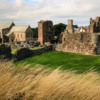Located 2 miles from the north-east coast of England and linked to the mainland by a tidal causeway, Lindisfarne has an area of some 1,000 acres and is the site of the first Christian monastery established by Saint Aidan in 635AD when he came here from the Irish monastery of Iona. With the support of King Oswald (based at nearby Bamburgh) he worked as missionary among the pagan English of Northumbria to bring Christianity to the kingdom. As a result the island also became known as The Holy Island.
The Christian ministry on Lindisfarne continued with the ministry of the very popular Saint Cuthbert who died in March 687 after which his remains were associated with a number of miracles. His body was removed from the island during the period of the Danish Viking attacks in 793AD.
At some time in the early 700s, the famous beautiful illuminated manuscript known as the Lindisfarne Gospels, an illustrated Latin copy of the Gospels of Matthew, Mark, Luke and John, was made at Lindisfarne probably by a monk named Eadfrith, who became Bishop of Lindisfarne in 698 and died in 721. These magnificently illustrated and bejeweled gospels are thought to have be prepared to venerate the works of St Cuthbert.
I have always thought Lindisfarne to be a fascinating and magical isle, situated, as it is, out in the oft foggy, cold, rainy and fierce North Sea through which the Vikings had often sailed their long ships to raid our shores. I had long wanted to see the island and visit the remains of the original abbey. When the opportunity came during a recent spell of good weather on that coast I was enchanted by the sight of the old "rainbow" arches and fallen stones lying beside St. Mary's church with it's old weathered gravestones carved with stories of those hardy islanders of years gone by. Behind the abbey and across the small harbour, Lindisfarne Castle, built in 1550 from the stones of the ruined abbey, sits on a mound and faces protectively out to sea watching for the Danish invaders who never came back.


Comments (1)